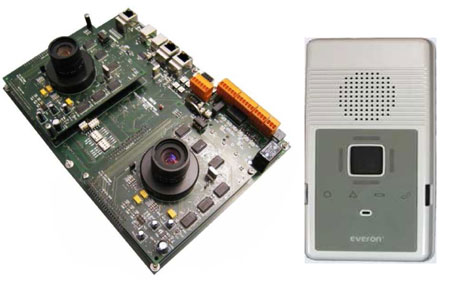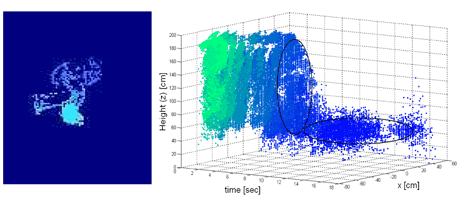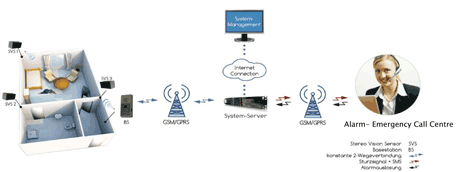by Ahmed Nabil Belbachir, Ferenc Vajda, Tommi Lunden and Erwin Schoitsch
In the frame of CARE, a co-funded project within the first call of EC-AAL (Ambient Assisted Living) joint programme initiative, we have developed a new technology with on-board fall detection for elderly safety at home. The system includes a visual sensor and a wireless communication module integrated into the already-established product “Everon caring system”. This new sensor technology allows real-time detection of a person’s fall by permanently monitoring, analysing and interpreting elderly activity at home, and automatically sending an alarm in case of falls. The system takes advantage of the strength of visual sensing without intruding on the individual's privacy.
Europe is ageing. The percentage of the population that is 65 years or older, and the life expectancy is rising. The number of elderly people will be more than double by 2050 and the proportion of people living alone will increase. One of the highest risks for elderly persons living alone or spending much time alone is falling down (Figure 3) and being unable to call for help, especially in case of loss of consciousness. The main challenge in installing ICT-based monitoring systems is finding the balance between surveillance and privacy, ie, home safety versus ethics. Since privacy is a fundamental human right, any means of improving safety in the living environments of elderly persons need to respect and ensure privacy. Falls can occur in all home locations and situations. Wearable tools currently used for monitoring are often not continuously used by elderly persons, rendering them of little use for detecting potentially hazardous situations. As a consequence, “smart ambient” approaches, like vision-based surveillance, appear to be more appropriate for that purpose. This CARE initiative is an end-user driven R&D activity where end-users represent major players in AAL activities in the context of safety and independent living. The consortium is well balanced two research institutes (AIT, Budapest University of Technology and Economics), two small and medium enterprises (Everon, SensoCube) and two end-users (Senioren Wohnpark Weser in Germany and Yrjö & Hanna homes in Finland). Selected elderly homes of the partner end-users are used for the evaluation and demonstration of the CARE concept (Figure 3).

Figure 1: CARE key technologies: Stereo vision system for fall detection (left), Everon wireless module (right).
In the early phase of the project, it was necessary to conduct interviews with end-users, collect a list of needs and to find out the most important safety-relevant situations encountered. More than 200 end-users in Austria, Finland, Germany and Hungary were questioned. These end-users agreed about a definitive need for a fall detector at elderly homes and that the actual fall detectors (eg wearable systems) are not satisfactory and do not have high acceptance in the independent living context. Based on these interview results, a list of requirements was created for the CARE ICT system with a focus on the fall detection as the main target. Architecture for a biologically-inspired stereo vision sensor was designed (Figure 1- left) and the sensor and algorithms for the detection of falls were developed. The CARE system is currently under testing and evaluation with first installations in Germany.

Figure 2. Left: CARE data from the stereo sensor of a fall instant rendered in an image-like representation; Right: the spatiotemporal 4D data of a person during a fall from walking position.
Figure 2 shows the visual data from the CARE dynamic stereo sensor, which do not correspond to an image but to scene dynamics (ensure privacy) such that events representing contours are only generated upon person motion. In the left, the instant acquisition of the fall is recorded in an-image like representation. The right figure shows the 4D representation of the fall (space and time). The depth is color coded so that with rising distance between the object and the sensor the object is marked darker (from green to blue). The person walks away from the sensor and falls after 9 sec in the same direction of his walking. Therefore the color of the data points representing the person decreases with time from bright to dark blue. CARE mainly targets single individual elderly people living in their own private homes (Figure 4) with a huge potential. The AAL market is changing and is expected to boom in the next few years as a result of demographic developments and large investments of industries and stakeholders. Actual products, which are on the market for several years, mainly consist of wearable systems and intelligent floor technologies; however their success is restricted to limited markets like nursing homes rather than the broader aged communities. In the context of independent living, wearable systems do not have the best acceptance for primary end-users (elderly), especially those who are not impaired.

Figure 3: CARE system and service chain.
The CARE system for fall detection services is integrated with the Everon caring system (see Figure 1, right) for wider deployment in Europe, strengthening the independent living market and society.
Link: http://www.care-aal.eu
Please contact:
Ahmed Nabil Belbachir, Erwin Schoitsch, AIT Austrian Institute of Technology / AARIT, Austria
E-mail: {nabil.belbachir, erwin.schoitsch}@ait.ac.at
Ferenc Vajda
Budapest University of Technology and Economics, Hungary
E-mail:
Tommi Lunden
Oy Everon Ab, Finland
E-mail:










